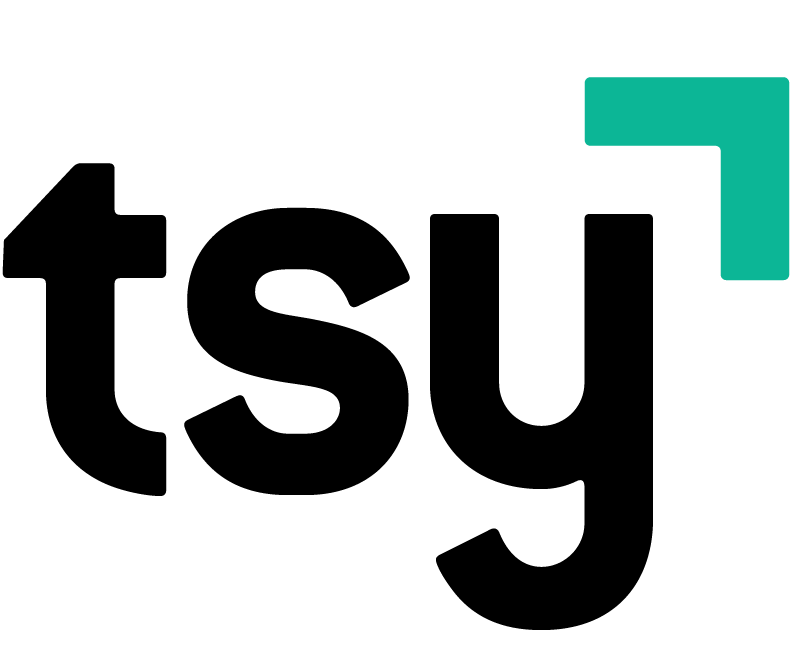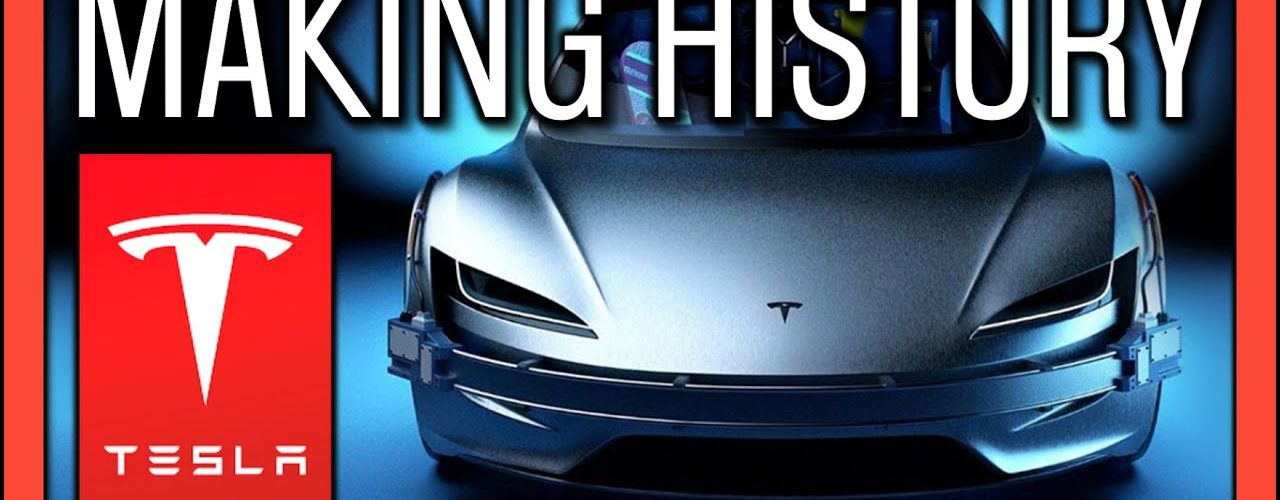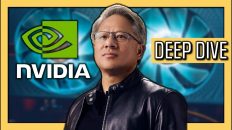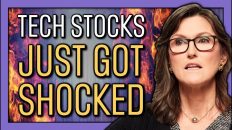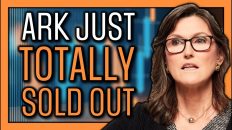Mentioned in Video:
- ⚡ ARK Invest's HUGE Tesla Stock (TSLA) Price Target & Predictions for Electric Vehicles: https://www.youtube.com/watch?v=rzTS6Nz8ATQ
- 🤓 Tesla's HUGE Data Lead, S&P 500 Inclusion, Rise of Mobile Streaming: https://www.youtube.com/watch?v=-R4bCLgwy94
- 🚗 Tesla Battery Day: https://www.youtube.com/watch?v=l6T9xIeZTds
- 🎤 Cathie Wood's Full Interview with Kamco Invest: https://www.youtube.com/watch?v=NN5zTgUfwQs
- WHITE PAPER – Disruptive Innovation: Why Now? (Brett Winton, ARK Invest): https://ark-invest.com/white-papers/innovation-why-now-white-paper/
- #ARK’s Price Target for Tesla in 2025: https://ark-invest.com/articles/analyst-research/tesla-price-target-2/
- ARK Invest Big Ideas Report 2021: https://ark-invest.com/big-ideas-2021/
- Support the channel and get extra member-only benefits by joining us on Patreon: https://www.patreon.com/tickersymbolyou
⚡ #Tesla stock (#TSLA) is the biggest position in every #ARKInvest fund it's in (#ARKK, #ARKW, #ARKQ). Tesla just released FSD Beta 9, moving their full self-driving solution to vision-only for the first time. This episode focuses on what #CathieWood thinks are Tesla's biggest competitive advantages, how it will keep making history, and why it's still @ARK Invest‘s biggest investment, even after growing more than 500% over the last two years! Here's why TSLA is still one of the best stocks to buy now!
Video Transcript:
[00:00:00.000]
With regards to Tesla, your views, why Tesla versus the others? For me, it's always been confusing to find a company that's just starting out being this size in terms of market cap, the size of the entire automotive industry at one point. So, please, maybe you can explain some of that to me.
[00:00:19.390]
Tesla is one of the most difficult companies to really understand and even more difficult to value. It's not a car company, it's not an energy company, and it's not a software company. Despite climbing by well over 500% in the last two years, Tesla stock, ticker symbol TSLA is still ARK Invest's number one holding by a huge margin, meaning Cathie Wood's performance is heavily tied to Tesla's. So in this episode, I'd like to show you how exactly I think Tesla fits into ARK Invest's current vision of the future, a few key competitive advantages they have over other automakers, and why Cathie Wood believes Tesla could still grow by 60% per year to $3,000 per share over the next five years.
[00:01:01.500]
If you enjoy this type of commentary and analysis, consider liking this video and subscribing to the channel with all notifications turned on. That way, you'll be the first to know when I come out with new research, regardless of how YouTube tunes its algorithm. Let's drive right into it. Starting with ARK Invest's vision of the future and Tesla's place in it. A little over two years ago, Brett Winton, the director of research at ARK Invest, wrote a white paper called Disruptive Innovation. Why now? It's actually a really easy read and it's filled with great information.
[00:01:30.760]
I've referenced this paper in many of my previous episodes and in all of my own investments. I'll leave a link to it in the description below, but there are two figures that I really think highlight ARK Invest's longterm vision of the future. The first one is a timeline of innovation platforms that have transformed humanity going all the way back to the steam engine. The Y axis of this plot is the net impact of these technologies and innovations to our overall productivity. For example, think about how different our lives, our jobs and the markets would be without the telephone, the automobile and electricity, all of which started back in the early 1900s.
[00:02:07.140]
Then we have computers in the 1980s and the Internet in the in early 2000s, each of which had huge positive impacts to our overall productivity. Today, ARK Invest has identified five innovation platforms that they think are about to change the world in huge ways. Energy storage, artificial intelligence, robotics, genome sequencing, and blockchain technology. Here's the thing about Tesla. It exists at the intersection of three of these platforms: energy storage, artificial intelligence, and robotics. The intersections between these platforms are the point of the second figure I want to show you:
[00:02:41.130]
ARK Invest's clusters of major innovation platforms. The big bubbles are the five key innovation platforms that are evolving right now, and the smaller ones are nine more disruptive technologies that are evolving from their overlaps. Whenever I'm deciding whether or not to invest in a company, I always try to identify where it would go on this chart. As I begin highlighting Tesla's competitive advantages, let's keep track of which innovation platforms they fall under. Let's start with the core technology platform that Teslas are built on: their batteries, which are, in my opinion, their most immediate competitive advantage.
[00:03:15.000]
Here's Cathie Wood putting Tesla's battery technology in this same historical context in a recent webinar with Kamco Invest.
[00:03:22.200]
Yeah. So Tesla, what happened there? Well, I think what happened was again, these auto companies hadn't changed in a hundred years, and they didn't have to. They changed incrementally. And here you get this upstart this pipsqueak, this rebel saying, in the early days, I'm going to build my car on top of cell phone batteries. And mind you, cell phone batteries were blowing up on planes and were banned, right? So the auto industry laughed at him, and auto analysts laughed at him, and we took what he was doing and said, okay, let's see if we can figure out what the heck he's talking about here.
[00:04:07.530]
And this comes down to that learning curve and cost decline and which is all important in innovation. What he effectively was doing is he was taking a technology that had been riding down a cost curve for years. It's called the consumer electronics industry, think cell phones and laptops and anything, any electric device. And he basically said, I am going to build this car on top of a cost curve that has been falling for years. And I'm going to accelerate that decline with a new use case.
[00:04:46.770]
And so that's what he did. With cylindrical batteries, lined the bottom of the car. Whereas most other auto manufacturers, their form factor and their batteries were very different: lithium ion pouch batteries, which were at a much higher cost point. So we mapped out those two cost curves, and we said, okay, when will the traditional auto manufacturers with their battery technology become competitive with Tesla's? And we thought that was going to be in the early 20s. But because of the innovation around the battery pack system that Elon, putting silicon inside the anode of the battery and experimenting with other chemistries, we believe Tesla is still three years ahead of the traditional auto industry.
[00:05:39.540]
So that's the historical context for how and why Tesla's cylindrical battery architecture, which is the kind found in consumer electronics, is so different from the lithium ion pouch batteries found in more traditional automobiles. In terms of battery architecture, Tesla is moving away from battery packs and moving toward using batteries as part of the car structure. Kind of like how modern aircraft wings aren't actually just wings, but wing shaped fuel tanks, fuel literally fills the entire wing of an airplane, maximizing the amount of fuel it can hold and minimizing the amount of metal that's doing nothing but adding weight.
[00:06:14.630]
On top of that, the actual batteries themselves are getting better. There's a sweet spot in battery cell diameter between lowering cost and increasing range. So Tesla is building their new cells in that sweet spot. Their latest battery cells are called the 4680s because they have a 46 millimeter outer diameter and an 80 millimeter height. The problem with bigger batteries is that electrons have to travel further to get to to the exit, which is called the tab. So, Tesla came up with a new tablets design that changes how electrons reach this exit.
[00:06:44.720]
This design is also simpler and has fewer parts, making it cheaper to make. By the way, this tablets design addresses another common complaint that drivers of internal combustion engines have about switching to electric. Charging time goes from this to this because the electrons can take the same shorter path into the battery as they would flowing out of it. This is a huge deal for power draw. Like Cathie Wood mentioned, there's also important advancements being made in the battery chemistry itself. For example, Tesla is adding in raw Silicon and a polymer coding, which allows batteries to expand a bit without failing and increases the range by up to 20%.
[00:07:20.810]
And of course, since they're in control of their battery chemistry, Tesla can separate batteries by application and make the most of their resources. They can use more nickel for highpower applications like moving a lot of mass. They can use manganese with nickel to increase range for premium vehicles and have lithium iron batteries for the cars where cycle life matters more than range, like in Tesla's power packs and in the small cars designed for urban areas. This is a huge advantage of Tesla being so tightly vertically integrated and that leads us right into their second competitive advantage, which might also be their most long term advantage.
[00:07:56.570]
Tesla's gigafactories, which are the machines that build the machines. In my opinion, Tesla is a world leader in robotics and automation, which allows them to rapidly iterate on machines and manufacturing processes to squeeze the most out of every resource they have. Here's a quick clip from Tesla's most recent battery day presentation, which I feel really showcases how Elon Musk and the team at Tesla think about extending their competitive advantages in manufacturing in the decades to come.
[00:08:23.860]
We'll probably be on machine revision six or seven by the time we do large scale production. The rate at which the machines are being improved is extremely rapid, like literally every three or four months, is a new Rev.
[00:08:35.640]
The key to a high performing assembly line is accomplishing processes while in motion, continuous motion and thinking of the line as a Highway, max velocity down the highway, no start and stop, no city driving. And together with our internal design team that makes this equipment and designs this equipment, we coupled thinking about how to make the best sell with thinking about how to make the best equipment so that we could accomplish the fastest parts per minute rates on all of these tools. And through all of that development, we were able to get to the point where we can implement assembly lines.
[00:09:07.110]
One line, 20 gigawatt hours, seven times increase in output per line.
[00:09:12.480]
If you break the factory down into cubic meter sections and say or it could be like one liter sections and say, is a majority of this volume doing useful work, you'd be astounded at how bad most factories are. They're like maybe two or 3%, including our factory in Fremont. So I think it is possible to get to at least ten times that volumetric efficiency. So more like 30% ish maybe more and be ten x better, which means the factory can be ten times smaller. And then the other thing is, how fast are things going?
[00:09:47.310]
Like a factory that's moving, let's say twice the speed of another factory is equivalent to two factories basically. And the company that will be successful is the company that with one factory can accomplish what other companies take two or three or four factories to do.
[00:10:01.640]
If you haven't seen Tesla's whole Battery Day presentation, I'll leave a link to it in the top right hand corner of your screen right now and in the description below as well. It seems that Elon Musk also takes lessons from history. The continuous motion assembly lines of the gigafactories are taking inspiration from those of printing, bottling factories and even toy cars. Current car bodies are made up of hundreds of individual parts, which are made from many different materials and must be joined together in several different ways.
[00:10:29.180]
Think welding, bolting and adhesives. Tesla is going to use two castings for the front and rear underbody sections and connect them with the structural battery pack I mentioned earlier. To make these Giga castings happen, Tesla has to create their own aluminum alloy that doesn't need heat treatment to be strong. The final result of building the car with these Giga castings and connecting them with the structural battery pack is that Teslas could be up to 10% lighter and gain 14% increased range. Just to be clear, 14% on a 300 miles range is an extra 42 miles per charge.
[00:11:01.490]
If Tesla's competitors don't start doing this themselves, they'll need to find another way to make up that 14% range gap. It's a huge differentiator. Currently, their wet process for making batteries requires several massive machines and processing plants to mix, coat, dry and compress the electrodes. Note the human on each of these rows for scale. Their new dry electrode process turns the mixed powder directly into film. The powder takes far fewer smaller machines to mix and can be applied as coating without being dried or compressed. Tesla's third competitive advantage is the one ARK Invest's evaluation model for Tesla really depends on. The prospect of full self driving, or FSD. To enable FSD,
[00:11:42.890]
Tesla makes their own full self driving chip and are billions of miles ahead of their competition when it comes to collecting training data for full self driving.
[00:11:51.370]
No one else is doing an AI chip. Tesla designed its own chip and took a leaf from Apple's playbook. This is very important. Why did Apple, the upstart in the cell phone market, why did it win the lion share of the profits in that market? It saw the world a little differently. While Nokia, Motorola and Ericsson were designing new phones with fashion in mind and form factor in mind, Apple said, Wait a minute. This is going to be a computer. Consumers will be able to, and businesses will be able to access the Internet through a smartphone.
[00:12:34.220]
No one was thinking that in 2007 or 2008, it designed its own chip and it's taken the lion share of the profits. Same thing with Tesla: designed its own chip, no one else has done it. And then beyond that, the third barrier to entry is the amount of data it has accumulated with the robots riding around the roads. My model three is one of them. They get data all day every day.
[00:13:01.990]
I'm recording this one night before version nine of Tesla's full self driving Autopilot Beta will be made available to early testers via an over the year update, according to Tweets by Elon Musk. Beta 9 is the first version of Tesla's vision only system, meaning the cars will no longer rely on radar to drive themselves. Range information helps cars do things like knowing to brake for obstacles and maintain the speed of the car in front of them. Because they use radio waves, radars can see through snow, rain, fog, dust, and have no trouble seeing at night.
[00:13:32.110]
However, radars tend to be pretty low resolution compared to cameras, meaning they have a harder time telling the shape of an object, so cameras tend to do that job. Radars can also have a lot of false detections, which can cause issues like phantom braking when the car tries to stop you from hitting something that isn't really there. So removing radars means removing all of the benefits of all weather detection and all of the drawbacks of trying to clean up, combine and make sense of noisy radar data in real time.
[00:14:00.150]
The magic here is that Tesla already has radar data alongside all of the billions of miles of camera data for their fleet so far, so they can use that to help train their vision-only version of FSD to do better depth detection. Andrej Karpathy is the senior director of AI at Tesla, where he leads the computer vision team for Autopilot. Here's a quick clip where he talks about how to extract depth information from camera data, as well as using radar data to help train a vision only AI.
[00:14:28.140]
How you can arrive at depth perception from vision alone. So here's a video of a Tesla so our cameras are sensing, and we're looking at I'm only showing the main camera, but all the cameras are turned on the eight cameras. And if you just have the six second clip, what you can do is you can stitch up this environment in 3D using multi view stereo techniques. So so this is the 3D reconstruction of those 6 seconds of that car driving through that path, and you can see that this information is purely is very well recoverable from just videos.
[00:15:00.220]
So it's remarkable. All that information is really there in the sensor, and just a matter of extracting it. The other project that I want to briefly talk about is we use the forward facing radar, which is shown in blue, and that radar is looking out and measuring depths of objects. And we use that radar to annotate what vision is seeing. The bounding boxes that come out of the neural networks. So instead of human annotators telling you, okay, this car in this bounding box is roughly 25 meters away.
[00:15:27.440]
You can annotate that data much better using sensors. So you use sensor annotation. So as an example, radar is quite good at that distance. You can annotate that, and then you can train your network on it. And if you just have an update of it, this neural network is very good at predicting those patterns. So here's an example of predictions of that. So in circles, I'm showing radar objects and the key points that are coming out here are purely from vision, and the depth of those key points is learned via sensor annotation from the radar.
[00:15:56.770]
So if this is working very well, then you would see that the circles in the top down view would agree with the key points, and they do. And that's because neural networks are very competent at predicting depths, they can learn the different sizes of vehicles internally, and they know how big those vehicles are, and you can actually drive depth from that quite accurately.
[00:16:12.600]
Before becoming the senior director of AI at Tesla, Andrej Karpathy was a founding member and research scientist at Open AI, and before that, he designed and taught the first deep learning class at Stanford. My point is, Tesla's expertise in artificial intelligence is as world class as their expertise in robotics through the innovations in their gigafactories and their expertise in energy storage thanks to their innovations in battery technologies. So this is how I would map Tesla onto ARK Invest's clusters of major innovation platforms. A good gut check is that Tesla sits at the top of ARKW, which focuses on artificial intelligence and ARKQ, which focuses on autonomous vehicles, energy storage, robotics, and automation, all of which we've covered in this episode. The Holy Grail that sits at the overlap of these three innovation platforms is autonomous mobility, which in this case would be Tesla's robotaxi network at scale.
[00:17:05.340]
If Andrej Karpathy's team at Tesla can get full self driving to work with vision only, it's because of the mountains of training data they have to train their AI, something none of Tesla's competitors have. So let's ask the big question, how likely is it that Tesla actually pulls this off first? And what would it mean for them if they do?
[00:17:23.100]
There's a 50% shot that it gets autonomous, right, and does develop a commanding lead in the US, if not elsewhere. And we think autonomous taxi networks will submit to natural geographic monopolies. So those who invest the most aggressively now in artificial intelligence, data collection, robotics expertise, software as a service expertise, and of course, battery technology are going to be the winners. We think Tesla is the winner in the United States. That's our bet. We are taking a close look at Cruise Automation, which GM owns, Waymo, Google and so forth.
[00:18:12.210]
From what we can see, what we can discern, we think that Tesla is still in the pole position so that's our $3,000 price target. The stock is, I guess it's closing in on $700 once again, so that's a healthy return over. I think it's north of 60% compound annual rate of return in the next five years.
[00:18:33.900]
Coming out with a simpler, cheaper vision only solution before their competitors can come out with more expensive solutions that still rely on radar and LiDAR would mean multiple massive advantages for Tesla: lower costs, higher reliability, simpler maintenance, and so on. I hope this episode helped you understand Tesla's deep expertise and competitive advantages in energy storage, robotics and artificial intelligence, which are three of ARK Invest's five major innovation platforms, as well as how Tesla's vision-only full selfdriving solution could set them apart from the others. If it did, let me know by investing in the like button and subscribing to the channel with all notifications turned on, that's a great way to invest in the channel that invests in you. Until next time.
[00:19:17.800]
This is Ticker Symbol: You. My name is Alex, reminding you that the best investment you can make is in you.
If you want to comment on this, please do so on the YouTube Video Here
